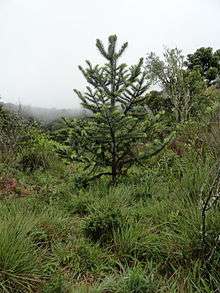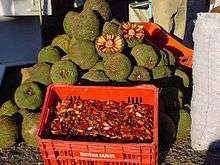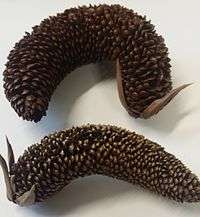Araucaria angustifolia
| Araucaria angustifolia | |
|---|---|
 | |
| Mature tree | |
| Scientific classification | |
| Kingdom: | Plantae |
| Division: | Pinophyta |
| Class: | Pinopsida |
| Order: | Pinales |
| Family: | Araucariaceae |
| Genus: | Araucaria |
| Section: | A. sect. Araucaria |
| Species: | A. angustifolia |
| Binomial name | |
| Araucaria angustifolia | |
| Synonyms | |
| |
Araucaria angustifolia, the Paraná pine, Brazilian pine or candelabra tree (pinheiro-do-paraná, araucária or pinheiro brasileiro), is a critically endangered species in the conifer genus Araucaria. Although the common names in various languages refer to the species as a "pine", it does not belong in the genus Pinus (this was due the limited knowledge the first europeans had when arrived in the region and was later kept in the popular culture).
Origin and taxonomy
The genus Araucaria was part of terrestrial flora since theTriassic and found its apogee in Gondwana. Today, it is restricted to the Southern Hemisphere and has 19 species.[3] The species Araucaria angustifolia was originated at the start of the Jurassic, about 200 million years ago, and its primitive occurrence is very different to the present day, fossils were found in the Northeast Region, Brazil.http://www.ipef.br/identificacao/araucaria.angustifolia.asp The species sprawl is recent, taking place during the later Pleistocene and early Holocene. It may be the possible result of a climatic change and of migration of floras of mountain regions through river courses.[4][5]
Distribution
Covering an original area of 233,000 square kilometres (90,000 sq mi),[6] it has now lost an estimated 97% of its habitat to logging, agriculture, and silviculture.[1] People also eat the fruit and seeds, which reduces propagation.[1] It is therefore listed as critically endangered.[1]
It is native to southern Brazil (also found in high-altitude areas of southern Minas Gerais and in the east and south of São Paulo, but more typically in the states of Paraná, Santa Catarina and Rio Grande do Sul). According to a study made by the Brazilian researcher, Maack, the original area of occurrence represented 36.67% of the Paraná state (73,088 km2 or 28,219 sq mi), 60.13% of the Santa Catarina state (57,332 km2 or 22,136 sq mi), 21.6% of the São Paulo state (53,613 km2 or 20,700 sq mi) and 17.38% of the Rio Grande do Sul state (48,968 km2 or 18,907 sq mi).[6] It is also found in the northeast of Argentina (Misiones and Corrientes) and locally in Paraguay (Alto Paraná), growing in low mountains at altitudes of 500–1,800 metres (1,600–5,900 ft).
Description


It is an evergreen tree growing to 40 m (130 ft) tall and 1 m (3 ft 3 in) diameter at breast height. The leaves are thick, tough and scale like, triangular, 3–6 centimetres (1.2–2.4 in) long, 5–10 millimetres (0.2–0.4 in) broad at the base, and with razor-sharp edges and tip. They persist 10 to 15 years, so cover most of the tree except for the trunk and older branches. It is closely related to Araucaria araucana from further southwest in South America, differing most conspicuously in the narrower leaves.
It is usually dioecious, with the male and female cones on separate trees. The male (pollen) cones are oblong, 6 cm (2.4 in) long at first, expanding to 10–18 cm (4–7 in) long by 15–25 mm (0.6–1.0 in) broad at pollen release. Like all conifers it is wind pollinated. The female cones (seed), which mature in autumn about 18 months after pollination, are globose, large, 18–25 cm (7–10 in) in diameter, and hold about 100–150 seeds. The cones disintegrate at maturity to release the approximately 5 cm (2 in) long nut-like seeds, which are then dispersed by animals, notably the azure jay, Cyanocorax caeruleus.
The inner bark and resin from the trunk of the tree is reddish, which can be a good defining character because it differs from Araucaria araucana, which has brown bark inner and white resin.[7]
It prefers well drained, slightly acidic soil but will tolerate almost any soil type provided drainage is good. It requires a subtropical climate with abundant rainfall, tolerating occasional frosts down to about −5 to −20 °C (23 to −4 °F).
The seeds are very important for the native animals. Several mammals and birds eat pinhão, and it has an important ecological role in Araucaria moist forests (a sub-type of the Brazilian Atlantic Forest). The species is widely used in folk medicine.[8]
Human use


It is a popular garden tree in subtropical areas, planted for its unusual effect of the thick, 'reptilian' branches with a very symmetrical appearance.
The seeds, similar to large pine nuts, are edible, and are extensively harvested in southern Brazil (Paraná, Santa Catarina and Rio Grande do Sul states), a habit particularly important for the region's small population of Native Americans. The seeds, called pinhão [piˈɲɐ̃w̃] are popular as a winter snack. The city of Lages, in Santa Catarina state, holds a popular pinhão fair, in which mulled wine and boiled araucaria seeds are consumed.
In Brazil, 3,400 tonnes (7,500,000 lb) of seeds are collected annually which, combined with extensive logging, seriously threatens the regeneration of the species.
It is also used as a softwood timber in stair treads and joinery.[9]
References
- 1 2 3 4 Thomas, P. (2013). "Araucaria angustifolia". The IUCN Red List of Threatened Species. IUCN. 2013: e.T32975A2829141. doi:10.2305/IUCN.UK.2013-1.RLTS.T32975A2829141.en. Retrieved 10 January 2018.
- ↑ Carrière Traité Gén. Conif. 415 1855
- ↑ "ALEXANDRE BERNARDI KOEHLER" (PDF). Floresta.ufpr.br (in Portuguese). Retrieved 19 July 2018.
- ↑ Müller-Starck, Gerhard & Schubert, Roland. Genetic response of forest systems to changing environmental conditions. Springer, 2001. p. 94
- ↑ Registros históricos da Araucária - Entrevista com Hermann Behling. Unisinos. Disponível em Amaivos, acesso 24 fev 2011
- 1 2 Helton Damin da Silva; Antonio F. Jurado Bellote; Carlos Alberto Ferreira; Itamar Antonio Bognola (2001). "Recomendação de solos para Araucaria angustifolia com base nas suas propriedades físicas e químicas" (PDF). Boletim de Pesquisa Florestal. 43: 61–74. Archived from the original (PDF) on 2007-06-09.
- ↑ Farjon, Aljos (2010). A handbook of the world's conifers. Netherlands: Brill Publishers. p. 188. ISBN 9789004177185.
- ↑ A. M. Freitas; M. T. R. Almeida; C. R. Andrighetti-Fröhner; F. T. G. S. Cardozo; C. R. M. Barardi; M. R. Farias & C. M. O. Simões (2009). "Antiviral activity-guided fractionation from Araucaria angustifolia leaves extract". Journal of Ethnopharmacology. 126 (3): 512–517. doi:10.1016/j.jep.2009.09.005. PMID 19761825.
- ↑ Buckley, Michael (2005). "A basic guide to softwoods and hardwoods" (PDF). worldhardwoods.com. Retrieved 1 October 2017.
